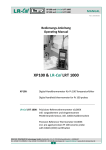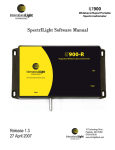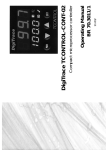Download AKG WMS40 / DIV / 880 Professional Microphone
Transcript
WMS40 User Instructions Please read the manual before using the equipment! Table of Contents Page FCC Statement . . . . . . . . . . . . . . . . . . . . . . . . . . . . . . . . . . . . . . 16 1 Safety and Environment . . . . . . . . . . . . . . . . . . . . . . . . . . . . . 16 1.1 Safety . . . . . . . . . . . . . . . . . . . . . . . . . . . . . . . . . . . . . . . 16 1.2 Environment . . . . . . . . . . . . . . . . . . . . . . . . . . . . . . . . . . 16 2 Description . . . . . . . . . . . . . . . . . . 2.1 Introduction. . . . . . . . . . . . . . 2.2 Unpacking . . . . . . . . . . . . . . 2.3 Optional Accessories . . . . . . 2.4 SR 40 Receiver . . . . . . . . . . . 2.5 HT 40 Handheld Transmitter . 2.6 PT 40 Bodypack Transmitter . 2.7 Color Code Table . . . . . . . . . . . . . . . . . . . . . . . . . . . . . . . . . . . . . . . . . . . . . . . . . . . . . . . . . . . . . . . . . . . . . . . . . . . . . . . . . . . . . . . . . . . . . . . . . . . . . . . . . . . . . . . . . . . . . . . . . . . . . . . . . . . . . . . . . . . . . . . . . . . . . . . . . . . . . . . . . . . . . . . . . . . . . . . . . 16 16 17 17 17 18 18 19 3 Setting Up . . . . . . . . . . . . . . . . . . . . . . . . . . . . . . . . . . . . . . . . 20 3.1 Placing the Receiver . . . . . . . . . . . . . . . . . . . . . . . . . . . . 20 3.2 Mounting the Feet on the Receiver . . . . . . . . . . . . . . . . . 20 3.3 Rack Mounting a Single Receiver . . . . . . . . . . . . . . . . . . 20 3.4 Rack Mounting Two Receivers Side by Side . . . . . . . . . . 20 3.5 Connecting the Receiver to a Mixer. . . . . . . . . . . . . . . . . 20 3.6 Connecting the Receiver to an Amplifier . . . . . . . . . . . . . 21 3.7 Connecting the Receiver to Power . . . . . . . . . . . . . . . . . 21 3.8 Inserting Batteries in the Handheld/Bodypack Transmitter and Testing . . . . . . . . . . . . . . . . . . . . . . . . . . . . . . . . . . . 21 3.9 Setting Up the Handheld Transmitter. . . . . . . . . . . . . . . . 22 3.10 Setting Up the Bodypack Transmitter . . . . . . . . . . . . . . . 22 3.11 Replacing the Handheld Transmitter Color Code Clip . . . 23 3.12 Before the Soundcheck. . . . . . . . . . . . . . . . . . . . . . . . . . 23 4 Microphone Technique . . . . . . . . . . . . . . . . . . . . 4.1 HT 40 Handheld Transmitter . . . . . . . . . . . . 4.2 C 417 L Lavalier Microphone. . . . . . . . . . . . 4.3 D 420 L, C 444 L Head-worn Microphones . . . . . . . . . . . . . . . . . . . . . . . . . . . . . . . . . . . . . . . . . 23 23 24 24 5 Cleaning . . . . . . . . . . . . . . . . . . . . . . . . . . . . . . . . . . . . . . . . . . 25 5.1 Surfaces . . . . . . . . . . . . . . . . . . . . . . . . . . . . . . . . . . . . . 25 5.2 HT 40 Internal Windscreen . . . . . . . . . . . . . . . . . . . . . . . 25 6 Troubleshooting. . . . . . . . . . . . . . . . . . . . . . . . . . . . . . . . . . . . 25 7 Specifications . . . . . . . . . . . . . . . . . . . . . . . . . . . . . . . . . . . . . . . 15 FCC Statement This equipment has been tested and found to comply with the limits for a Class B digital device, pursuant to Parts 74, 15, and 90 of the FCC Rules. These limits are designed to provide reasonable protection against harmful interference in a residential installation. This equipment generates, uses, and can radiate radio frequency energy and, if not installed and used in accordance with the instructions, may cause harmful interference to radio communications. However, there is no guarantee that interference will not occur in a particular installation. If this equipment does cause harmful interference to radio or television reception, which can be determined by turning the equipment off and on, the user is encouraged to try to correct the interference by one or more of the following measures: • Reorient or relocate the receiving antenna. • Increase the separation between the equipment and the receiver. • Connect the equipment into an outlet on a circuit different from that to which the receiver is connected. • Consult the dealer or an experienced radio/TV technician for help. Shielded cables and I/O cords must be used for this equipment to comply with the relevant FCC regulations. Changes or modifications not expressly approved in writing by AKG Acoustics may void the user’s authority to operate this equipment. This device complies with Part 15 of the FCC Rules. Operation is subject to the following two conditions: (1) this device may not cause harmful interference, and (2) this device must accept any interference received, including interference that may cause undesired operation. 1 Safety and Environment 1.1 Safety 1. Spill no liquids on the equipment and do not drop any objects through the ventilation slots in the equipment. 2. Do not place the equipment near heat sources such as radiators, heating ducts, or amplifiers, etc. and do not expose it to direct sunlight, excessive dust, moisture, rain, mechanical vibrations, or shock. 1.2 Environment 1. Be sure to dispose of used batteries as required by local waste disposal rules. Never throw batteries into a fire (risk of explosion) or garbage bin. 2. When scrapping the equipment, remove the batteries, separate the case, circuit boards, and cables, and dispose of all components in accordance with local waste disposal rules. 2 Description 2.1 Introduction 16 Dear Customer: Thank you for purchasing an AKG product. This Manual contains important instructions for setting up and operating your equipment. Please take a few minutes to read the instructions below carefully before operating the equipment. Please keep the Manual for future reference. Have fun and impress your audience! 2 Description Two different WMS 40 Systems are available: 2.2 Unpacking 1 SR 40 Receiver 1 HT 40 Handheld Transmitter 1 AC power adapter for 12 V DC 2 AA size 1.5 V dry batteries 1 screwdriver 1 stand adapter, black color code clip 1 SR 40 Receiver 1 PT 40 Bodypack Transmitter 2.2.1Handheld System: 2.2.2 Bodypack System: 1 AC power adapter for 12 V DC 1 screwdriver 2 AA size 1.5 V dry batteries Please check that the packaging contains all system components as listed above. If anything is missing, please contact your AKG dealer. RMU 60 19” rack mounting kit for 2 SR 40 receivers CH 40 plastic carrying case for one complete WMS 40 system. 2.3. Optional Accessories The SR 40 is a stationary non-diversity receiver for use with all WMS 40 transmitters. The SR 40 operates on one fixed, quartz stabilized frequency in the 710 MHz to 865 MHz UHF carrier frequency range and features a rack-mount case. 2.4 SR 40 Receiver 1 2 POWER: On/off pushbutton switch and indicator LED. Antenna: Fixed-length UHF antenna permanently mounted on the front panel. VOLUME: This rotary control adjusts the SR 40’s output level from microphone to line level for matching to the input sensitivity of your mixer or amplifier. RF: This LED lights to indicate that signal is being received. If no signal is received or the squelch is on, the RF LED goes out and the audio output is muted. Color Code: The color indicates the carrier frequency of your receiver. Transmitters tuned to the same frequency are marked with identical colors. 2.4.1 Front Panel Controls Carrier Frequency Label: A label indicating the carrier frequency and approval marks of your receiver is affixed to the rear panel of the receiver. 2.4.2 Rear Panel Controls Refer to fig. 2. 3 4 5 6 Refer to fig. 1. Refer to section 2.7 Color Code Table. 17 2 Description 7 MIC OUT: Balanced 3-pin XLR audio output for connecting to, e.g., a microphone input on a mixing console. 8 LINE OUT: Unbalanced audio output on a 1/4” mono jack for connecting to, e.g., a guitar amplifier. 9 Screwdriver for adjusting the SQUELCH control on the receiver and the GAIN control on the bodypack transmitter. 10 Strain Relief for the feeder cable of the supplied AC adapter. 11 DC IN: Input connector for the supplied AC adapter. 12 SQUELCH: The squelch circuit switches the receiver off if the received signal is too weak, in order to suppress the related noise or the residual noise of the receiver while the transmitter is off. Set the SQUELCH control to minimum before first switching the receiver on. (For details, refer to section 3.12.) 2.5 HT 40 Handheld Transmitter The HT 40 handheld transmitter operates on one fixed, quartz stabilized frequency in the 710 MHz to 865 MHz UHF carrier frequency range and uses an antenna integrated in the body. The microphone element permanently mounted on the transmitter is acoustically identical to the D 880 vocal microphone from AKG. This microphone features a built-in wind and pop filter to reduce wind and breath noise and provides low handling noise sensitivity, high gain before feedback, and brilliant sound quality. 2.5.1 Controls 13 On/Off switch: This slide switch provides three positions indicated in the display window: ON: Power to the transmitter is on. MUTE: The signal delivered by the microphone element is muted while power and the RF carrier frequency remain on. This prevents the receiver from responding to interference from other transmitters. OFF: Power to the transmitter is off. 14 Status LED: Indicates battery status. LED flashes momentarily upon switching ON and extinguishes: batteries are OK. LED lights constantly: batteries will be dead in about 50 minutes. 15 Color Code: The color of this plastic clip indicates the carrier frequency of your transmitter. Receivers tuned to the same frequency are marked with the same color. You can remove the color code clip on the HT 40 and replace it with the supplied black clip. 16 Battery Compartment Lid: Refer to section 3.8. 17 Carrier Frequency Label: The label above the battery compartment indicates the carrier frequency and approval marks of your transmitter. Refer to fig. 3. Refer to section 2.7 Color Code Table. 2.5.2 Optional Accessory 2.6 PT 40 Bodypack Transmitter 18 W 880 foam windscreen You can use the PT 40 bodypack transmitter with both dynamic microphones and condenser microphones operating on a supply voltage of approx. 3.8 V. You may also connect an electric guitar, electric bass, or remote keyboard. The PT 40 operates on one fixed, quartz stabilized frequency in the 710 MHz to 865 MHz UHF carrier frequency range. 2 Description 18 On/Off Switch: This slide switch provides three positions labeled as follows: ON: Power to the transmitter is on. MUTE: The signal delivered by the microphone or instrument is muted while power and the RF carrier frequency remain on. This prevents the receiver from responding to interference from other transmitters. OFF: Power to the transmitter is off. 19 Status LED: Indicates battery status. LED flashes momentarily upon switching ON and extinguishes: batteries are OK. LED lights constantly: batteries will be dead in about 50 minutes. 20 Audio input: 3-pin mini XLR connector with both mic and line level pins that automatically match the connector pinout of the recommended AKG microphones or optional MKG/L guitar cable. 21 Antenna: Permanently connected, flexible antenna. 2.6.1 Top Panel Controls 22 Belt Clip for fixing the transmitter to your belt. 23 Battery Compartment Lid: Refer to section 3.8. 24 MIC/LINE: This slide switch sets the audio input either to microphone level (“MIC” position) or line level (“LINE” position). 25 GAIN: This rotary pot matches the sensitivity of the transmitter’s audio section to the level of the connected microphone or instrument. 26 Carrier Frequency Label: The label on the transmitter rear panel indicates the carrier frequency, color code (receivers with the same carrier frequency are marked with the same color), and approval marks of your transmitter. 2.6.2 Rear Panel Controls The PT 40 has been designed specifically for use with the following AKG microphones: C 417 L C 420 L C 444 L 2.6.3 Microphones, Guitar Cable (optional) Refer to fig. 4 Refer to fig. 5. The MKG/L guitar cable from AKG lets you connect an electric guitar, electric bass, or remote keyboard to the bodypack transmitter. 2.6.4 Optional Accessory CB 40 bag Frequency 710.400 MHz 734.600 MHz 802.525 MHz 812.800 MHz 854.900 MHz 858.200 MHz 863.100 MHz 864.375 MHz Color reddish brown purple Bordeaux red yellow violet green melon yellow gray 2.7 Color Code Table 19 3 Setting Up Important: Prior to setting up your WMS 40, check that the transmitter and receiver are tuned to the same frequency. The easiest way to do this is to compare the color codes on the transmitter and receiver. 3.1 Placing the Receiver Reflections off metal parts, walls, ceilings, etc. or the shadow effects of musicians and other people may weaken or cancel the direct transmitter signal. For best results, place the receiver as follows: 1. Place the receiver near the performance area (stage). Make sure, though, that the transmitter will never get any closer to the receiver than 10 ft (3 m). Optimum separation is 16 ft. (5 m). 2. Check that you can see the receiver from where you will be using the transmitter. 3. Place the receiver at least 5 ft. (1.5 m) away from any big metal objects, walls, scaffolding, ceilings, etc. You can either use the receiver free-standing or mount it in a 19” rack using the optional RMU 60 rack mounting kit. 3.2 Mounting the Feet on the Receiver Refer to fig. 6. 1. Place the receiver with the bottom panel up on a flat surface. 2. Slide the two supplied side panel moldings (27) with the rubber feet facing up into the fixing rails on both sides of the receiver from rear to front. 3. Use the supplied Phillips screws to fasten the side panel moldings (27) to the receiver. 3.3 Receiver Rack Mounting a Single Receiver Refer to figs. 7a and 7b. Refer to fig. 7c. 1. Place a clamping slide (28) on each rack ear (29), checking that the pegs on the clamping slides (28) engage in the fixing holes on the rack ears (29). 2. Slide the clamping slides (28) and rack ears (29) into the fixing rails on both sides of the receiver from rear to front. 3. Tighten the two Phillips screws in the clamping slides (28) CW to fix the rack ears (29) on the receiver. 4. Use the supplied screws to fix the supplied blank panel to the left or right rack ear (29). 5. Use the supplied installation screws to install the receiver in the rack. Refer to fig. 7d. 3.4 Rack Mounting Two Receivers Side by Side Refer to fig. 7. 3.5 Connecting the Receiver to a Mixer Refer to fig. 8a. 20 1. Fix one rack ear (29) to the outside panel of each receiver referring to steps 1 through 3 above. 2. Insert a clamping slide (28) with no rack ear (29) into the fixing rails on the INSIDE PANEL of one receiver. 3. Insert the receiver with the clamping slide (28) on its inside panel into the fixing rails on the inside panel of the other receiver. 4. Tighten the two Phillips screws in the inside clamping slide (28) CW to connect the two receivers. 5. Use the supplied installation screws to install the receivers in the rack. You can connect the receiver to a mixer in one of two ways: A. Use a standard XLR cable to connect the MIC OUT connector (7) on the receiver rear panel to a balanced XLR microphone input on the 3 Setting Up mixer. Turn the VOLUME control (3) on the receiver all the way CCW to set the receiver output to microphone level. B. Use a standard 1/4” jack cable to connect the LINE OUT jack (8) on the receiver rear panel to an unbalanced 1/4” line input jack on the mixer. Turn the VOLUME control (3) on the receiver all the way CW to set the receiver output to line level. Refer to fig. 8b. Never use the two audio outputs simultaneously! This may cause signal loss or increased noise. Important: 1. Use a standard 1/4” jack cable to connect the LINE OUT jack (8) on the receiver rear panel to an unbalanced 1/4” line input jack on the amplifier. 2. Turn the VOLUME control (3) on the receiver all the way CW to set the receiver output to line level. 3.6 Connecting the Receiver to an Amplifier 1. Point the antenna (2) upward. 2. Set the SQUELCH control (12) fully CCW. 3. Check that the AC mains voltage stated on the supplied AC adapter is identical to the AC mains voltage available where you will use your WMS 40. Using the AC adapter with a different AC voltage may cause irreparable damage to the unit. 4. Plug the feeder cable on the supplied AC adapter into the DC IN socket (11) on the receiver. 5. Bend part of the feeder cable into a small bight, pass the bight through the strain relief (10) from above, and place the end of the bight snugly against the hook on the strain relief (10). Tighten the cable. 6. Plug the AC adapter into a convenient power outlet. 7. Press the POWER switch (1) to switch power to the receiver ON. 3.7 Connecting the Receiver to Power 1. Depress the snap hook on the battery compartment lid (16)/(23). 2. Pull the battery compartment lid (16)/(23) down to remove it from the transmitter. 3.8 Inserting Batteries into the Handheld/Bodypack Transmitter and Testing The foam pads on the inside of the battery compartment lid (16)/(23) holds the batteries in place. Do not remove the foam pad. If you do, the batteries will not be held in place properly and may cause a rattling noise. 3. Insert the supplied batteries into the battery compartment conforming to the polarity marks. The transmitter will not function with incorrectly inserted batteries. 4. Set the on/off switch (13)/(18) to “ON” to switch the power to the transmitter on. The status LED (14)/(19) will flash momentarily. If the batteries are in good condition, the status LED (14)/(19) will extinguish. If the status LED (14)/(19) illuminates the batteries will be dead within about 50 minutes. Replace the batteries with new ones as soon as possible. If the status LED (14)/(19) fails to flash momentarily the batteries are dead. Insert new batteries. 5. To close the battery compartment, slide the battery compartment lid (16)/(23) onto the battery compartment from below to the point that it will click shut. Refer to fig. 9. Refer to fig. 10. Important: Refer to fig. 11. 21 3 Setting Up 3.9 Setting Up the Handheld Transmitter (Also refer to section 4 Microphone Technique.) 3.10 Setting Up the Bodypack Transmitter 3.10.1 Connecting a Microphone 1. Switch power to the receiver on and check the setting of the VOLUME control (3): Fully CCW if you connected the receiver to a microphone input. Fully CW if you connected the receiver to a line input. 2. Set the on/off switch (13) to “ON” to switch power to the transmitter on. Since the HT 40 handheld transmitter has been designed specifically for the integrated microphone element, there is no need to set gain on the handheld transmitter. Therefore, the handheld transmitter has no level or gain control. 3. Switch power to your sound system or amplifier on. 4. Talk or sing into the microphone and set the levels on your mixer or amplifier referring to the appropriate instruction manual or by ear. The PT 40 bodypack transmitter has been designed primarily for use with the C 417 L, C 420 L, and C 444 L microphones from AKG. If you wish to connect other microphones from AKG or other manufacturers to the PT 40, please note that you may have to rewire the existing connector of your microphone or replace it with a 3-pin mini XLR connector. Audio input (20) pinout: Pin 1: shield Pin 2: audio (inphase) Pin 3: audio A positive supply voltage of 3.8 V for condenser microphones is available on pin 2. Important: (Also refer to section 4 Microphone Technique.) 3.10.2 Connecting an Instrument Refer to fig. 12. 22 Please note that AKG cannot guarantee that the PT 40 bodypack transmitter will work perfectly with products from other manufacturers and any damage that may result from such use is not covered by the AKG warranty scheme. 1. Remove the battery compartment lid (23). 2. Set the MIC/LINE switch (24) to “MIC” and use the supplied screwdriver (9) to set the GAIN control (25) to a position halfway between full CCW and full CW. 3. Plug the mini XLR connector on the cable of your microphone into the audio input connector (20) on the bodypack transmitter. 4. Set the on/off switch (18) to “ON” to switch power to the transmitter on. 5. Switch power to the receiver and your sound system or amplifier on. 6. Talk or sing into the microphone and set the levels on your mixer or amplifier referring to the appropriate instruction manual or by ear. 1. Remove the battery compartment lid (23). 2. Set the MIC/LINE switch (24) to “LINE” and use the supplied screwdriver (9) to set the GAIN control (25) to a position halfway between full CCW and full CW. 3. Plug the 1/4” jack plug on the optional MKG/L guitar cable to the output jack on your instrument and the mini XLR connector on the guitar cable into the audio input connector (20) on the bodypack transmitter. 3 Setting Up 4. Set the on/off switch (18) to “ON” to switch power to the transmitter on. 5. Switch power to the receiver and your sound system or amplifier on. 6. Play your instrument and set the levels on your mixer or amplifier referring to the appropriate instruction manual or by ear. 1. Use a screwdriver to lift the upper end of the color code clip (15). 2. Pull the color code clip (15) off the transmitter case. 3. Slide the supplied black clip onto the transmitter to the point that it snaps into place with an audible click. 3.11 Replacing the Handheld Transmitter Color Code Clip Refer to fig. 13. 1. Move the transmitter around the area where you will use the system to check the area for "dead spots", i.e., places where the field strength seems to drop and reception deteriorates. If you find any dead spots, try to eliminate them by repositioning the receiver. If this does not help, avoid the dead spots. 2. If unwanted noise becomes audible, turn the SQUELCH control (12) on the receiver CW just enough to suppress the noise. The RF LED (4) will extinguish every time the squelch mutes the audio output of the receiver. 3.12 Before the Soundcheck Never set the squelch threshold higher than absolutely necessary. The higher the squelch threshold, the lower the sensitivity of the receiver and thus the usable range between transmitter and receiver. Important: 3. The RF LED (4) on the receiver going out means no signal is being received or the squelch is active. Remedies: Switch power to the transmitter ON, move closer to the receiver, or turn the SQUELCH control (12) CCW to the point that the RF LED (4) will come back on. 4 Microphone Technique A handheld vocal microphone provides many ways of shaping the sound of your voice as it is heard over the sound system. The following sections contain useful hints on how to use your HT 40 handheld transmitter for best results. 4.1 HT 40 Handheld Transmitter Basically, your voice will sound the bigger and mellower, the closer you hold the microphone to your lips. Moving away from the microphone will produce a more reverberant, more distant sound as the microphone will pick more of the room’s reverberation. You can use this effect to make your voice sound aggressive, neutral, insinuating, etc. simply by changing your working distance. Proximity effect is a more or less dramatic boost of low frequencies that occurs when you sing into the microphone from less than 2 inches. It gives more “body” to your voice and an intimate, bass-heavy sound. 4.1.1 Working Distance and Proximity Effect 23 4 Microphone Technique 4.1.2 Angle of Incidence Refer to fig. 14. 4.1.3 Feedback Refer to fig. 15. 4.1.3 Backing Vocals Refer to fig. 16. Sing to one side of the microphone or above and across the microphone’s top. This provides a well-balanced, natural sound. If you sing directly into the microphone, it will not only pick up excessive breath noise but also overemphasize “sss”, “sh”, “tch”, “p”, and “t” sounds. Feedback is the result of part of the sound projected by a speaker being picked up by a microphone, fed to the amplifier, and projected again by the speaker. Above a specific volume or “system gain” setting called the feedback threshold, the signal starts being regenerated indefinitely, making the sound system howl and the sound engineer desperately dive for the master fader to reduce the volume and stop the howling. To increase usable gain before feedback, the microphone element of the HT 40 handheld transmitter has a supercardioid polar pattern. This means that the microphone is most sensitive to sounds arriving from in front of it (your voice) while picking up much less of sounds arriving from the sides or rear (from monitor speakers for instance).main (“FOH”) speakers in front of the microphones (along the front edge of the stage). If you use monitor speakers, be sure never to point any microphone directly at the monitors, or at the FOH speakers. Feedback may also be triggered by resonances depending on the acoustics of the room or hall. With resonances at low frequencies, proximity effect may cause feedback. In this case, it is often enough to move away from the microphone a little to stop the feedback. 1. Never let more than two persons share a microphone. 2. Ask your backing vocalists never to sing more than 35 degrees off the microphone axis. The microphone is very insensitive to off-axis sounds. If the two vocalists were to sing into the microphone from a wider angle than 35 degrees, you may end up bringing up the fader of the microphone channel far enough to create a feedback problem. 4.2 C 417 L Lavalier Microphone 1. Fix the microphone to the H 40/1 lavalier clip or H 41/1 tie pin referring to the C 417 L instruction manual. 2. Clamp the microphone on your clothing as close as possible to your mouth. Remember that gain-before-feedback will be the higher the smaller the distance between the microphone and the mouth! 3. Make sure to aim the microphone at your mouth. 4.3 C 420 L, C 444 L Head-worn Microphones Refer to the user’s manual of the respective microphone for instructions on how to use head-worn microphones. 24 5 Cleaning Use a soft cloth moistened with water to clean the receiver and transmitter surfaces. 5.1 Surfaces 1. Unscrew the wire-mesh cap of the handheld transmitter CCW and remove the wire-mesh cap from the transmitter. 2. Remove the windscreen (foam sheet) from the wire-mesh cap. 3. Wash the windscreen in mild soap suds. 4. As soon as the windscreen has dried, replace it in the wire-mesh cap and screw the wire-mesh cap onto the transmitter CW. 5.2 HT 40 Internal Windscreen 6 Troubleshooting Problem No sound. Noise, crackling, unwanted signals. Possible Cause Remedy 1. AC adapter is not connect- 1. Connect AC adapter to ed to receiver and/or power receiver and/or power outoutlet. let. 2. Receiver is OFF. 2. Push POWER switch to switch receiver ON. 3. Receiver is not connected 3. Connect receiver output to to mixer or amplifier. mixer or amplifier input. 4. VOLUME control on receiv- 4. Turn up VOLUME control. er is at zero. 5. Microphone or instrument 5. Connect microphone or is not connected to bodyinstrument to audio input pack transmitter. on bodypack. 6. Transmitter and receiver 6. Use receiver and transcolor codes are not mitter with identical color identical. codes. 7. Transmitter on/off switch is 7. Set transmitter on/off at “OFF” or “MUTE”. switch to “ON”. 8. Transmitter batteries are 8. Insert batteries conforming not inserted properly. to “+” and “-” marks. 9. Transmitter batteries dead. 9. Replace batteries. 10.Transmitter is too far away 10.Move closer to receiver or from receiver or SQUELCH turn down SQUELCH concontrol set too high. trol. 11.Obstructions between 11.Remove obstructions from transmitter and receiver. between transmitter and receiver. 12.Receiver is invisible from 12.Avoid spots where you transmitter location. cannot see receiver. 13.Receiver is too close to 13.Move receiver away from or metal objects. remove interfering objects. 1. Antenna location. 1. Relocate receiver. 2. Interference from other 2. Switch off interference wireless systems, TV, radio, sources or defective appliCB radios, or defective ances or use a WMS 40 electrical appliances or tuned to a different freinstallations. quency; have electrical installation checked. 25 6 Troubleshooting Problem Distortion. Possible Cause Remedy 1. (Bodypack transmitter 1. Turn GAIN control down or only:) GAIN control is set up just enough to stop the too high or too low. distortion. 2. Interference from other 2. Switch off interference wireless systems, TV, radio, sources or defective appliCB radios, or defective ances or use a WMS 40 electrical appliances or tuned to a different freinstallations. quency; have electrical installation checked. Momentary loss of sound 1. Antenna location. (“dropouts”) at some locations within performance area. 1. Relocate receiver. If dead spots persist, mark and avoid them. 7 Specifications Carrier frequency range Modulation Audio bandwidth Frequency stability (-10°C to +50°C) Rated deviation T.H.D. at 1 kHz Compander Signal/noise ratio RF output Current consumption Power requirement Battery life Input sensitivity Audio input level for rated deviation Input impedance HT 40 710 to 865 MHz FM 40 to 20,000 Hz PT 40 710 to 865 MHz FM 40 to 20,000 Hz SR 40 710 to 865 MHz FM 40 to 20,000 Hz ±15 kHz 15 kHz typ. 0.8% Yes typ. 103 dB(A) 10 mW typ. 70 mA 2 x 1.5 V AA size batteries typ. 30 hours - ±15 kHz 15 kHz typ. 0.,8% Yes typ. 103 dB(A) 10 mW typ. 70 mA 2 x 1.5 V AA size batteries typ. 30 hours 300 mV (MIC); 110 mV (LINE) typ. 140 kΩ//450 pF (LINE) 3.8 V/4.7 kΩ (pin 3) - ±15 kHz typ. 0.8% Yes typ. 103 dB(A) 95 ±15 mA 120/230 V AC 50/60 Hz typ. -95 dBm - 100 mV/1 kHz 220 kΩ Condenser mic power supply Squelch threshold Audio outputs Size (WxDxH) Net weight 26 length: 258 mm (10 in.) 64 x 22 x 96 mm dia.: 40 mm (1.6 in.) (2.5 x 0.9 x 3.8 in.) 245 g (8.7 oz.) 76 g (2.7 oz.) -70 to -98 dBm XLR bal. and unbal. 1/4” jack: adjustable from mic to line level: 2 Vrms max. 235 x 142 x 43 mm (9.3 x 5.6 x 1.7 in.) 470 g (16.6 oz.) Fig. 3 Fig. 4 PT 40 HT 40 WMS 40 Fig. 5 SR 40 Wireless Microphone System 21 Fig. 1 22 14 2 26 19 13 4 1 3 5 20 18 15 24 Fig. 11 PT 40 25 17 ON MUTE OFF 16 Fig. 10 23 Fig. 11 HT 40 2 – 7 + + – Fig. 13 Fig. 2 2 x 1.5V Fig. 8a 2 x 1.5V 20 + 10 Fig. 12 10 – + 8 11 12 9 29 28 6 – 24 27 25 Fig. 8b Fig. 14 Fig. 15 29 Fig. 16 28 1 a b c d Fig. 9 27 2 Fig. 7 27 3 Fig. 6
























